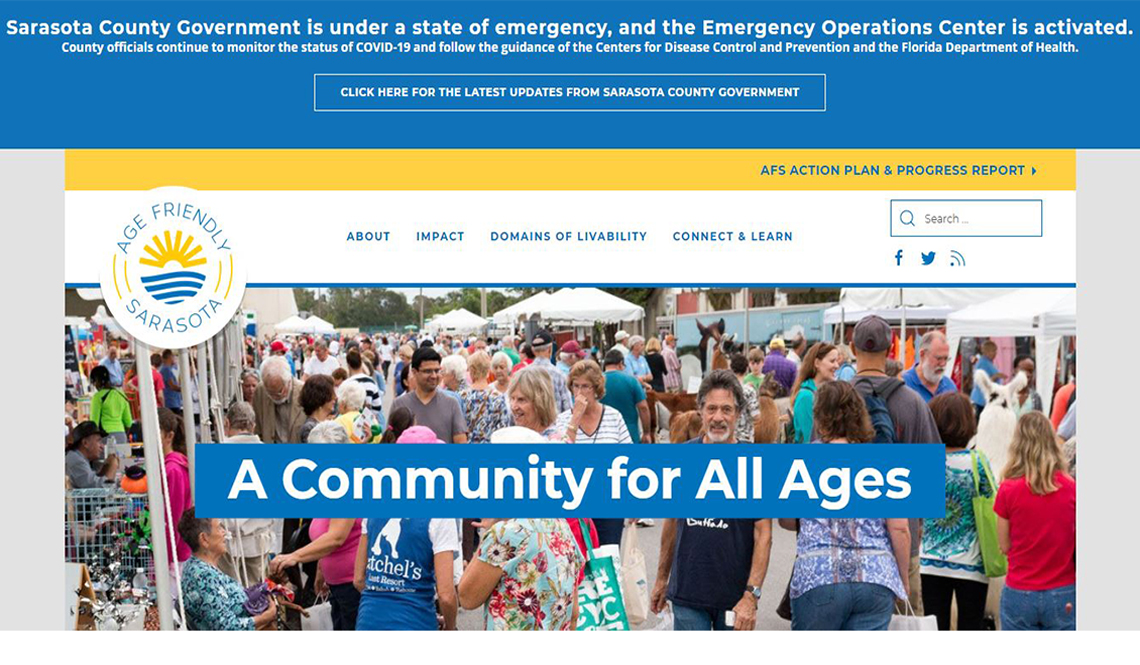Age-Friendly Sarasota County, Florida, Responds to COVID-19
A look at how the community is serving and protecting its older residents
Located on Florida's Gulf Coast, Sarasota County is a community of about 415,000 people, 150,000 of whom are age 65 or older. Roughly 56,000 people reside in the city of Sarasota, where 27 percent of the population is age 65-plus.
The county joined the AARP Network of Age-Friendly States and Communities in 2015. Its age-friendly initiative is called Age-Friendly Sarasota.
Community Representative:
- Susan Firestone, Aging System Policy Coordinator, Sarasota County Health and Human Services, explains how the community is helping its older residents during the coronavirus pandemic.
(Information provided to AARP on May 20, 2020)
The Challenge
"Ensuring that residents have easy access to relevant information has been critical throughout this event. In addition, we expected this crisis would increase the need for feeding and hydration services, so as a county we've prioritized coordinating and providing access to meal delivery services."
The Response
"The Sarasota County government immediately created a COVID-19 resource page on the county website. The page provides quick access to specific resources such as the modified bus schedules, a digital library of resources, park and beach updates and information for businesses. Other critical information displayed includes information from the governor’s office, the emergency declaration, all executive orders and heat maps of COVID-19 cases by zip-code.
The Focus Area
"The county also set up a text alert system that residents can sign up for to receive regular updates. The Sarasota Community Organizations Active in Disasters coalition (referred to as Sarasota COAD) is extremely active and involved and sends out information daily to contacts.
"On March 18, Sarasota County’s Office of Emergency Management, agency partners, service providers and other community partners developed a multi-agency feeding plan for vulnerable populations. The plan outlines tiered activation levels based on service thresholds and action steps to be taken once those thresholds are met.
Response Partners
"The plan details the phases of an initial feeding phase, increased distribution feeding phase, and disaster feeding phase, followed by a decrease in surge need and a recovery phase. Each is mapped in accordance with the expected number of meals needed per day.
"The plan prioritizes meal delivery for seniors living alone without transportation, homebound residents, Sarasota County transportation dependents, and people experiencing homelessness, among others. The planning team for this initiative receives weekly information from service providers of the number of meals served that week, including from All Faiths Food Bank, Senior Friendship Centers and Meals on Wheels. The team also tracks SNAP [Supplemental Nutrition Assistance Program] and unemployment applications by zip-code.
"To expand our reach, new sites for meals have been added as a need was determined in the community. Sarasota County approved the use of county-owned vehicles to deliver meals. Our service providers have adapted quickly and increased capacity for new clients. For example, Senior Friendship Centers, our county’s lead agency, converted its congregate dining to home delivery and created an approved, expedited assessment process to add new clients with a direct call instead of having to go through the Elder Helpline. Many of our local farms have provided produce for the food boxes."
The Results, Thus Far
"We've had success as our partners and community are all working very well together. As we receive new and relevant information each week, a multi-agency committee works to meet the immediate needs. Through successful communication and coordination, we've seen a significant increase in the number of meals provided and have been able to meet the needs of our community."
Research by Shosanna Preuss | Article published May 2020
- Learn about the AARP Network of Age-Friendly States and Communities
- Check out the network's Member List
- Connect with AARP Florida
- Find more Age-Friendly Responses to COVID-19
Stay Informed
The weekly, award-winning AARP Livable Communities e-Newsletter provides local leaders with information and inspiration for making their town, city or neighborhood more livable for older adults and people of all ages. Subscribe today!
AARP.org/Livable
Enter a topic, name, place, etc.




